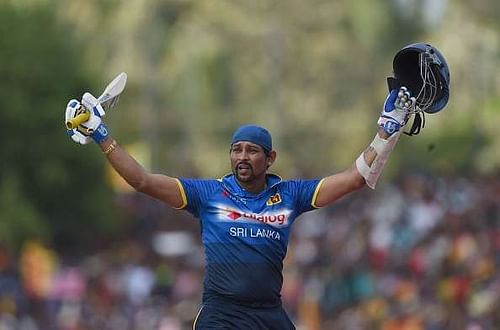
Tillakaratne Dilshan: The Swiss Army knife of cricket

He knelt down on one knee- his head lowered; eyes set on the ground. It was what could be termed as a gesture of capitulation. For ages, batsmen have averted their eyes or ducked under to avoid the wrath of the speeding leather. This was what gave bowlers a sadomasochist pleasure.
This was the goading that made bowlers have one more go at the batsman for there is no better enjoinment for an infiltrator than the sight of a receding army. This was what made them sniff blood. This was what made them regale themselves with the crepitation of cracking skulls.
But, much like King Leonidas of Sparta, Dilshan was hatching a vicious plan behind the façade of surrender. The 144 kmph missile was soon launched over the wicketkeeper’s head and miles into the stand. Neither King Leonidas nor Dilshan feared the opposition. And there is no man more dangerous than a man who is happy to die.
A man for all occasions and needs
For a long time, Dilshan was Sri Lanka’s Swiss Army knife. He was the one stop solution for the many ailments of the team. He was the wicketkeeper when the team needed a wicketkeeper. He was the short-leg when the team needed a short-leg. He was the point fielder when the team needed a point fielder. He was opener when the team needed an opener. He was the finisher when the team needed a finisher. He was the opening bowler when the team needed an opening bowler. He was the captain when the team needed a captain.
Every time the team needed someone, Dilshan became that someone. He was Sri Lanka’s favourite troubleshooter. He was the Ctrl+Alt+Delete of the team management.
Dilshan scored well in excess of 2000 runs batting at number six in tests and is one of the very few batsmen to have accomplished that feat. Bored by it, he moved up the order and scored another 2000 runs as an opener. Murali hated bowling with the new ball. So he bowled with the new ball whenever his team needed. Whenever Sangakkara was exhausted by batting through an innings, it was Dilshan who took the burden of crouching and squatting behind the stumps.
He was there where it was tough to field. He prowled in the point region during the first powerplay and then patrolled the long-off region during the slogfest at the death. And in Tests, as Murali spat poison with his off-breaks, it was Dilshan who formed a barricade at short-leg, at times even catching full blooded slogs. He is probably the only player to have opened the batting, opened the bowling, kept wickets and captained the team. As if they are not enough, he also went on to feature in a local movie.
Also read: What If: Kapil's Devils lost the 1983 World Cup Final
Dilshan was far from being perfect. But Sri Lanka’s success relied heavily on imperfections. Being rough around the edges was what made Sri Lanka imposing. The team did well not when they played by the rules but when they broke it. Like a good lawyer, Sri Lanka often found a way around rules. They weren’t a ray of light to travel straight. Instead, they were a stream of water that found its own path.
Sri Lanka couldn’t find a proper opener. So they found a short-cut in Sanath’s bulging forearms. Orthodox spin wasn’t working, hence they resorted to the mystery of Murali. Bowlers with a higher arm action didn’t even last the length of the board officials’ promise to revamp the domestic structure, so they came up with a round-arm Malinga.
In the stringent orthodoxy Mahela and Sanga brought to the national team, Dilshan stayed true to his national identity. What if you can’t whip a length bowl angled at you? You can always ramp it over the keeper!
Dilshan gave Sri Lanka a different dimension
Dilshan took risks. Dilshan took risks like a meth addict taking meth. Dilshan didn’t imprison himself with math or numbers, or with the useless piece of data analysts throw at you apprising you of the many different ways you could fail should you tread down the perilous path. There was only one thing Dilshan was under the control of- instincts. He listened to his heart. And his heart always told him to look at the opportunities; never at the threats.
Sangakkara and Mahela were cautious, cautious to the point that they, at times, failed even to take the chances that could have helped the side be better than what it was. They played it safe. Perhaps, with more players like Dilshan, Sri Lanka could have been dominant and not just consistent.
Great teams take great gambles. Taking risks can either escalate you to the level an emperor or reduce you to a destitute. Given the sort of risks he took, Dilshan could have been benched, dropped and might have retired in complete oblivion from a different profession. But Dilshan took that gamble and now he is Sri Lanka’s best ever limited overs player.
Also read: SK Flashback: When the 'Kohli Era' took flight in Sri Lanka
Dilshan was a liberator. In a sport shackled by the obsolete Victorian morality and strict adherence to decorum, Dilshan was a rebel. He had everything in him that earned the wrath of the conformists. From his bohemian facial hair to the ear stud, he challenged propriety.
If the cover drives were played with the front foot to the pitch of the ball, Dilshan played them with his front foot outside the leg stump. If balls short outside of off stump can only be cut, he reverse-pulled them over short third man. Dilshan showed the world there was no one way of playing cricket.